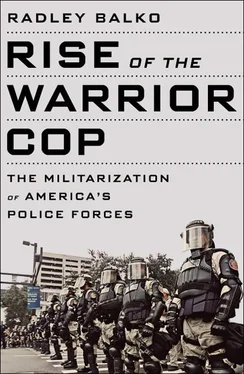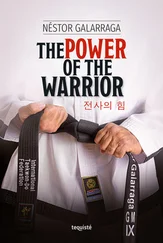The violent destruction of life and property incident to war—the continual effort and alarm attendant on a state of continual danger, will compel nations the most attached to liberty, to resort for repose and security, to institutions, which have a tendency to destroy their civil and political rights. To be more safe they, at length, become willing to run the risk of being less free. 9
But the federalists still believed that the federal government needed the power to raise an army. Those same liberties faced a greater threat from outside forces, and were likely to be obliterated entirely if the young nation was conquered by a foreign power. In the end, the federalists won the argument. There would be a standing army. But protection from its potential threats would come in an amendment contained in the Bill of Rights that created an individual right against quartering in peacetime. Even during wartime, quartering would need to be approved by the legislature, the branch more answerable to the people than the executive.
Taken together, the Third, Second, and Tenth Amendments indicate the Founders’ desire for the power to enforce laws and maintain order to be primarily left with the states. As a whole, the Constitution embodies the rough consensus at the time that there would be occasions when federal force might be necessary to carry out federal law and dispel violence or disorder that threatened the stability of the republic, but that such endeavors were to be undertaken cautiously, and only as a last resort. More importantly, the often volatile debate between the federalists and the antifederalists shows that the Third Amendment itself represented much more than the sum of its words. The amendment was in some ways a compromise, but it reflects the broader sentiment, shared by both sides, about militarism in a free society. Ultimately, the Founders decided that a standing army was a necessary evil, but that the role of soldiers would be only to dispel foreign threats, not to enforce laws against American citizens. 10

BEFORE THE BILL OF RIGHTS COULD EVEN BE RATIFIED, however, a rebellion led by a bitter veteran tested those principles. Daniel Shays was part of the Massachusetts militia during the Revolutionary War. He fought courageously at Bunker Hill, Lexington, and Saratoga. He was wounded in action and received a decorative sword from the French general Lafayette in recognition of his service. After the war ended, Shays returned to his farm in Massachusetts. It wasn’t long before he began receiving court summonses to account for the debts he had accumulated while he was off fighting the British. Shays went broke. He even sold the sword from Lafayette to help pay his debts.
Other veterans were going through the same thing—they were broke, often wounded from battle, and getting little help from the country they’d just fought to create. The debt collectors weren’t exactly villains either. Businesses too had taken on debt to support the war. They set about collecting those debts to avoid going under. Shays and other veterans attempted to get relief from the state legislature in the form of debtor protection laws or the printing of more money, but the legislature balked.
In the fall of 1786, Shays assembled a group of eight hundred veterans and supporters to march on Boston. They planned not only to close down the courthouses to prevent them from foreclosing on the veterans’ farms but also to forcibly free debtors from prison. The movement subsequently succeeded in shutting down some courtrooms, and some began to fear that it threatened to erupt into a full-scale rebellion.
In January 1787, Massachusetts governor James Bowdoin asked the Continental Congress to raise troops to help put down the rebels, but under the Articles of Confederation the federal government didn’t have the power to provide that sort of assistance to the states. So Bowdoin instead assembled a small army of mercenaries paid for by the same creditors who were hounding men like Shays. After a series of skirmishes, the rebellion had been broken by the following summer.
Shays’ Rebellion was never a serious threat to overthrow the Massachusetts government, much less that of the United States, and it was put down relatively quickly, without the use of federal troops, and with little loss of life beyond the rebels themselves. But its success in temporarily shutting down courthouses in Boston convinced many political leaders in early America that the country needed a stronger federal government. Inadvertently, Shays spurred momentum for what became the 1787 Constitutional Convention in Philadelphia.
The impact of Shays’ Rebellion didn’t end, however, at Philadelphia. Memories of the rebellion and fears that something like it could destabilize the new republic blunted memories of the abuses suffered at the hands of British troops and made many in the new government more comfortable with the use of federal force to put down domestic uprisings. 11
In 1792, just five years after the ratification of the Bill of Rights, Congress passed the Calling Forth Act. The new law gave the president the authority to unilaterally call up and command state militias to repel insurrections, fend off attacks from hostile American Indian tribes, and address other threats that presented themselves while Congress wasn’t in session. In addition to the concerns raised by Shays’ Rebellion, growing discontent over one of the country’s first federal taxes—a tax on whiskey—was also making the law’s supporters anxious. The Calling Forth Act allowed the president to federalize and deploy the militia “whenever the laws of the United States shall be opposed or the execution thereof obstructed, in any state, by combinations too powerful to be suppressed by the ordinary course of judicial proceedings, or by the powers vested in the marshals by this act.” Two years later, in 1794, President George Washington used the act to call up a militia to put down the Whiskey Rebellion in 1794 in western Pennsylvania.
The Calling Forth Act did expand the power of the executive, and Washington’s willingness to invoke it showed that the new government wouldn’t hesitate to use an armed force on its own citizens when faced with a violent uprising. But the law still authorized the president to call up such a force only in dire situations, and then only long enough to dispel the threat. That power would be further regulated, in 1807, with the Insurrection Act, which clarified that the president could call up the military to put down a rebellion only if so requested by a state; he could send in the military in spite of a state’s wishes only if he determined that the situation was so dire that federal law could no longer be enforced, or if the basic rights of the state’s citizens were being violated and the state couldn’t or wouldn’t do anything about it. The Insurrection Act, which stipulated that the military was to be used only as an absolute last resort, would be used in subsequent decades to put down slave rebellions and prison riots.
So ideas about law and order were already evolving. The young republic had gone from a country of rebels lashing out at the British troops in their midst to a country with a government unafraid to use its troops to put down rebellions. But American presidents had still generally adhered to the Symbolic Third Amendment. For the first half-century or so after ratification of the Constitution, military troops were rarely if ever used for routine law enforcement.
But that would soon change.
ON APRIL 8, 1851, CHARLES LORING STOOD UP IN A BOSTON courtroom to deliver his closing argument. He’d represented his client for only a few days, but the man’s freedom hung in the balance. Outside the courtroom, federal marshals, militia, and Boston constables and watchmen stood guard. Iron chains blocked all entrances to the building. Four days earlier, Thomas Sims, a seventeen-year-old escaped slave, had been arrested in the free state of Massachusetts. 12Sims had escaped the Savannah plantation of John Potter, one of the city’s wealthiest farmers. Sims then stowed away on a freight ship, which brought him to Boston. 13
Читать дальше













